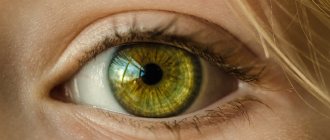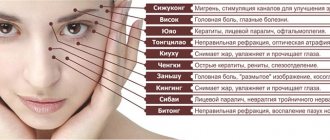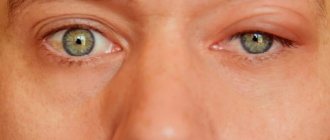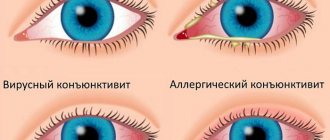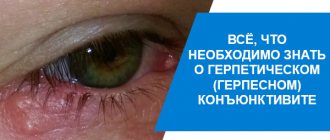Compresses and lotions soaked in plant decoctions have long been used to wash the eyes for ophthalmological diseases. Tea brewing has very good results. It eliminates inflammation of the organs of vision and relieves irritation. The tea leaves are often used to wash the eyes for conjunctivitis. How to do this correctly?
One of the most common ophthalmic pathologies is conjunctivitis in adults and children. Its distinguishing feature is inflammation of the conjunctiva.
In this article
- Allergic conjunctivitis
- Causes of allergies
- Bacterial conjunctivitis
- How to treat bacterial conjunctivitis?
- Viral conjunctivitis
- Herpetic conjunctivitis
- Washing eyes with tea
- How to wash your eyes with tea for conjunctivitis
This is the connective membrane of the eye, lining the inner surface of the eyelid and the eyeball to the cornea. This structure performs a very important function. It protects the organs of vision from external influences. For example, when a foreign object gets into the eye, the conjunctiva provides increased secretion of tear fluid so that the speck comes out along with the tear. However, she herself is quite vulnerable. When viruses, bacteria, or plant pollen enter the inner lining of the eyelid, inflammation begins, which is called “conjunctivitis.”
About 70% of people experience this eye disease at least once in their lives. If you promptly contact a specialist and begin therapeutic measures, conjunctivitis is not dangerous and can be cured in two weeks. However, once the disease starts, it can turn from an acute form into a chronic one. In this case, the healing process will take longer. In particularly severe cases of conjunctivitis, some eye structures may be significantly damaged. For example, vesicular ulcerative conjunctivitis can lead to severe ulceration of the corneal tissue, and this can lead to severe visual impairment and blindness. An ophthalmologist prescribes various drops and ointments to treat eyes with conjunctivitis: antiviral, antibacterial, antihistamine - depending on the type of disease.
However, official medicine fully recognizes the use of some folk methods and considers them effective as additional means of therapy. Thus, using tea for rinsing conjunctivitis helps to successfully eliminate purulent or mucous discharge from the eyes. It is necessary to properly prepare the tea leaves so as not to harm the visual organs. First of all, let's look at what types of conjunctivitis black or green tea can be used for.
Allergic conjunctivitis
Allergic inflammation of the eyes occurs as a reaction of the body when the mucous membrane is exposed to various substances.
In modern ophthalmology, many types of allergens are known. Here are the symptoms observed when allergies develop in adults and children:
- hyperemia (redness) of the conjunctiva, swelling of the eyelids;
- profuse lacrimation;
- itching and irritation;
- clear or mucous discharge;
- runny nose and cough.
With allergic conjunctivitis, the eyes itch all the time, which causes discomfort in everyday activities. It is impossible to wear contact lenses at this time, women are not allowed to paint their eyes, and it is difficult to maintain a normal rhythm of life. Just imagine that your nose is stuffy all the time, and tears flow from your reddened eyes, you are constantly sneezing and coughing. In the acute form of allergic conjunctivitis, adverse reactions may also occur, for example, Quincke's edema, urticaria, atopic dermatitis, etc.
The severity of allergic conjunctivitis depends on the amount of allergen that enters the mucous membrane of the eyes and the degree of vulnerability of the body. The rate of development of the reaction also varies, and it can appear immediately or after 1-2 days. According to the nature of the course, allergic conjunctivitis in children and adults is divided into acute, subacute or chronic.
Causes of allergies
Eye inflammation can occur for various reasons. Irritants are pollen of certain plants, medications, food products or their components, dust, etc. The disease is not contagious; it occurs in a specific person as an individual reaction. For example, when a birch tree blooms, millions of people feel normal, and only some of them experience allergic irritation of the mucous membranes. Conjunctivitis caused by exposure to allergens immediately manifests itself as irritation of the organs of vision - this is the first sign of this disease. In this way, the immune system responds to an antigen that poses a danger to people who are prone to an individual reaction to it.
To treat allergic conjunctivitis, antihistamines are used. The components included in this type of drops inhibit the effect of histamines on the body. Popular drugs for the treatment of allergic conjunctivitis include Cromohexal, Opatanol, Lecrolin, Alergoftal, Spersallerg, Alomide, Ketotifen. To eliminate irritation and itching, moisturizing drops “Vizin” and “Oftagel” are effective.
Non-steroidal drugs, in addition to relieving the symptoms of conjunctivitis, also have an analgesic effect. These include drops "Diclofenac", "Acular", "Indocollir".
Corticosteroid drugs are prescribed in cases where conventional anti-inflammatory and antihistamine drugs do not have the desired effect. They are highly effective in treatment, but they also have side effects: for example, increased intraocular pressure. Corticosteroids include Dexamethasone, Loteprednol, Prenacid, Maxidex.
Six ways to use black tea to treat various problems
Author Tatyana Piteryakova
27.10.2019 12:04
Health
We are used to drinking black tea in the morning; it is an excellent alternative to coffee and contains a minimum of caffeine. But it turns out that tea can not only be drunk, but also used to heal cuts and treat other problems that arise.
Remedy for scratches and cuts
Black tea is rich in phenolic compounds and tannins, which have an astringent effect. Therefore, used tea bags can be applied to cuts - thanks to the effect of tea, bleeding will be stopped.
As a result, swelling at the site of injury will decrease. In addition, tea will have a calming effect.
Baths for unpleasant foot odor
Of course, a person feels awkward if his feet smell bad. Black tea contains tannins that close pores and kill bacteria.
You need to pour 2 liters of warm water into a basin and put 2 tea bags in it, then keep your feet in this bath for 15-30 minutes. The procedure can be repeated daily. Thanks to it, your feet will not sweat as intensely.
Mouthwash for healthy gums
Black tea contains astringent acids that help relieve swelling and bleeding. Therefore, the brewed liquid is suitable for rinsing gums.
Drink to support immunity
Recently, researchers from the USA compared the content of black tea with the amount of nutrients in vegetables and fruits. As a result, they made an interesting conclusion: black tea, brewed and steeped for 5 minutes, is ahead of fruits and vegetables in terms of the content of useful components.
Eye Irritant Remedy
Human eyes often suffer from itching and dryness. In this case, the following remedy will help: place two tea bags in a glass of warm water for 10 minutes. Then you should squeeze them out and put them on your eyes for 10 minutes.
If your eyes are red, place moist, warm tea bags for 5 minutes, then cooler ones for 2 minutes. The tannins contained in black tea will help reduce swelling. The procedure can be repeated three times a day.
Medicine for herpes
Flavonoids and caffeine contained in black tea suppress the development of the virus. When herpes appears, apply a damp tea bag to the affected area and hold for 10 minutes.
For greater effectiveness, it is recommended to carry out the procedure three times a day. In the same way, the remedy will help get rid of ulcers and burns.
Black tea is not just a healthy drink, but also an effective remedy in the fight against herpes, swelling, unpleasant odor, etc. But most importantly, tea is harmless, so it is suitable for almost everyone.
Photo:gidabilgi.com
Topics herpes treatment black tea at home benefits of using black tea
Bacterial conjunctivitis
It develops when pyogenic (pus-producing) microorganisms enter the human body. These can be staphylococci, gonococci, chlamydia, Pseudomonas aeruginosa, etc.
The main symptom of the disease is purulent discharge from the eyes, which usually causes eyelashes to stick together, especially after sleep. In addition, conjunctivitis of a bacterial nature also has other manifestations:
- swelling and redness of the inner lining of the eyelid;
- itching and burning;
- dry skin around the eyes.
If conjunctivitis is not treated in time, the disease will go from acute to chronic, and then it will take a lot of time to eliminate the symptoms of the disease. The most severe damage is caused by gonococci and Pseudomonas aeruginosa. Untimely treatment can lead to severe ulceration of the cornea, which will cause permanent loss of vision.
Bacterial conjunctivitis often affects preschool children. Their level of personal hygiene is not yet sufficiently developed, and infectious diseases are easily spread through contact and household contact. Often conjunctivitis takes an epidemic course. The kindergarten is quarantined for 10-14 days, and the premises inside are thoroughly disinfected to prevent further spread of the disease. Many pathogenic organisms are very tenacious and can survive on contaminated surfaces in an active state for up to 7-10 days. Once you inhale contaminated dust particles, the microbes enter the mucous membrane of the nose, eyes, and lungs, causing the development of the disease.
How to treat bacterial conjunctivitis?
Drops and ointments with antibiotics help eliminate the symptoms of purulent conjunctivitis; in some cases, the doctor may prescribe corticosteroids. Children are prescribed antibacterial agents that are not absorbed into the blood, but act locally. Here are the drugs used in modern ophthalmology for the treatment of bacterial conjunctivitis:
Simple drops with one active antibiotic: “Cifran”, “Normax”, “Okacin”, “Ciprofloxacin”, “Tsipromed”, “Gentamicin”, “Norfloxacin”, “Tobramycin”. Combined eye drops with two types of antibiotics or corticosteroid hormone: Tobradex, Dexona, Maxitrol, Sofradex, Garazon. Antibacterial ointments: Framycetin, Tetracycline, Chloramphenicol, Sulfacetamide, etc.
The choice of drug depends on the type of bacterial conjunctivitis, the complexity of its course, and the age of the patient. It is unacceptable to choose treatments on your own, guided by advice from the Internet. Only a doctor can make a correct diagnosis and prescribe a drug that acts directly on the causative agent of the disease. Using the wrong medication can have negative consequences.
Viral conjunctivitis
The most common type of this eye pathology - of all types of conjunctivitis, it accounts for 85% of cases. It develops when various viruses penetrate the body: adenoviruses, enteroviruses, Coxsackie viruses, etc. Children under 6-7 years of age are especially susceptible to their effects. Their immune system is still very weak and cannot resist infections to the same extent as in adults. Viral conjunctivitis can occur independently or develop against the background of influenza, acute respiratory viral infections, acute respiratory infections, nasopharyngitis, and upper respiratory tract diseases. In such cases, complex treatment is prescribed.
Herpetic conjunctivitis
The herpes simplex virus is also often the cause of eye inflammation. It can provoke various types of herpetic conjunctivitis: catarrhal, follicular, vesicular-ulcerative.
After activation of the herpes virus, the following symptoms are observed:
- swelling and hyperemia of the inner membrane of the eyelid;
- pain in the eyes, lacrimation;
- clear or mucous discharge.
To eliminate the symptoms of viral conjunctivitis, medications containing interferon are used. They fight viruses, alleviate the symptoms of the disease and improve their general condition. These are drops and ointments such as “Actipol”, “Oftan Idu”, “Oftalmoferon”, “Oftan”, “Sodium Sulfacyl”, “Vitabakt”, “Levomycetin”, “Tobrex”, “Floxal”, etc. For herpetic form diseases, drops of Florenal, Zovirax, Virolex, etc. are used. If the virus has also affected the skin around the eyes, then Acyclovir and Valtrex ointments can be additionally prescribed. To avoid the addition of a bacterial infection, tetracycline or erythromycin ointments and antibiotic eye drops are additionally used.
For all types of conjunctivitis, it is recommended to wash the eyes to remove mucous or purulent discharge, as well as lotions to relieve swelling. Washing the eyes with tea is a popular procedure; it is believed that the substances contained in it have a good decongestant and antiseptic effect. Let's consider how appropriate it is to use tea leaves for various types of conjunctivitis.
Tea bags - how to use for benefits
Constant lack of sleep, lack of vitamins, poor nutrition, low physical activity and constant stress do not have the best effect on your appearance. The organ of vision is the first to react to this - multiple bruises, swelling, and redness of the eyes appear. A simple and effective remedy will help you cope with these problems – tea bags. They will perfectly cope not only with accumulated fatigue, but will also have a calming, strengthening and rejuvenating effect on the skin.
Content
- Benefits of tea bags for the eyes.
- Tea bags for puffiness under the eyes.
- Tea bags for bruises.
- Tea bags against barley.
- Mask for the eye area with a used tea bag.
- Other medicinal uses.
- Important details.
Benefits of tea bags for eyes
Experienced women have long stopped throwing away used tea bags, because this is the most valuable traditional medicine that helps the eyes regain lost clarity and beauty.
Other than that, this is a simple remedy:
- Eliminates swelling and dark circles.
- Relieves inflammation from the eyes.
- Perfectly soothes and disinfects.
- Supplies the skin around the eyes with useful substances, making it healthy and toned.
- Activates collagen synthesis, and therefore has excellent anti-aging properties (successfully fights fine wrinkles).
- The essential oils contained in tea allow you to turn a simple procedure into a full-fledged SPA treatment for the skin around the eyes.
- Tea compresses stimulate blood flow.
Note. White and green tea bags are considered the most valuable, but in Russia the more common black tea is mainly used for cosmetic purposes.
Tea bags for puffiness under the eyes
Every representative of the fair sex has used this simple method at least once. If you haven’t yet experienced a miraculous method of combating imperfections, then it’s time to try it.
The bottom line: after use, do not throw away the used sachets, but put them aside. Take two of these future compresses, dip them in warm water, squeeze them out and put them on the eye area for about 20 minutes. All this is done in a lying position, since it is important to relax as much as possible, relieving tension from the facial muscles, and rest a little.
Post Peeling skin: causes and treatment
The tea bag, due to its tannin and polyphenol content, has a positive effect on the condition of the skin under the eyes. Swelling subsides, the skin calms down and receives the necessary nutrition. In this case, you can make a full-fledged compress by placing tea bags so that they cover your eyes entirely. This procedure should take at least half an hour.
Tea bags for bruises
A late-night party, watching your favorite movie, or just working late at the computer in the morning will certainly remind you of yourself with redness or annoying bruises under the eyes. Then the same used tea bags will come to the rescue.
Just two pieces are enough. They are applied to the eyes soaked in warm water and kept for 15 minutes.
However, there is one important point here: as the bags cool, they should be turned over and then moistened again in warm water. This needs to be done several times.
Tea bags against barley
Incredibly, a used tea bag can also solve this problem perfectly. You just need to apply a wet bag to the sore spot. Leave for a while until it warms up to body temperature. Then take a new bag and do the procedure again.
It's all about tannic acid, which is found in abundance in tea. It is she who has the power to have a powerful antibacterial effect, relieving even very severe swelling. Sessions with the application of sachets should be repeated for 7 days in order to strengthen the result and prevent relapse.
Eye mask with a used tea bag
It is especially relevant for office workers who spend the lion's share of their time in front of a monitor. This mask will relieve fatigue from the eyes, remove inflammation, eliminate swelling and dark circles under the eyes.
You will need two freshly brewed tea bags. They should be placed in the freezer. While they are cooling, you need to prepare a special composition. Take 1 large spoon of finely grated raw potatoes, mix with 2 small spoons of heavy cream.
Post Summer skin care for face and body
After thorough mixing, the mask is distributed on the lower eyelids. Meanwhile, the cooled bags are placed over the eyes. After 20 minutes, the composition is washed off with warm water.
Other medicinal uses
Tea bags will help cope with both cosmetic problems and diseases of the mucous membrane. Acting as a powerful antiseptic, tea perfectly fights the inflammatory process, eliminates accumulated fatigue from the eyes and even heals from an unpleasant illness of cold origin - conjunctivitis.
If inflammation has already become apparent, then it is better to hurry and use the following useful recipe:
- Leave the strongly brewed tea and tea bag overnight. During this time, its astringent properties will significantly increase.
- Use cotton pads to wipe your eyes, moving from the outer corner to the inner.
- Finally, apply a compress. To do this, the tea is warmed up a little, and then the bags are placed on the eyes for 15 minutes.
The results of this procedure will be noticeable after just a couple of sessions.
Important! This simple recipe is absolutely safe for all categories of citizens, including the elderly and children. In addition, the use of tea bags is an excellent prevention of off-season colds.
Important nuances
In order for the effect of using tea bags for the eyes to meet expectations, it is necessary to take a responsible approach to the process of using them:
- Choose only a pure product, without any fillers, dyes or flavors. The latter can cause serious harm: provoke an allergic reaction, cause redness, irritation of the sensitive skin around the eyes, dry out the mucous membrane and even reduce visual function.
- A tea therapy session is not recommended before bedtime, since the product itself has the property of toning, fighting sleep and fatigue. There will certainly be a cosmetic effect, but going to bed late will nullify all the positive results.
- Black tea bags should not be left on the eyes for longer than expected, as this product tends to stain the skin a specific brown tint. And instead of one problem, a completely different one will appear: bruises and circles will be replaced by light brown stains. And this, in turn, will not add any attractiveness at all.
Post Wheat germ oil for face: benefits for skin, application
Currently, eliminating a wide variety of dermatological problems, including puffiness and dark circles under the eyes, using basic folk remedies is becoming increasingly popular. Tea bags, thanks to the safety of the active ingredient, ease of use, high efficiency and general availability, allow you to quickly and effectively solve all these problems, restoring beauty to your skin and clarity and radiance to your eyes.
Washing eyes with tea
Users often ask the question: is it possible to cope with conjunctivitis by rinsing your eyes with tea? Of course, this is impossible, any doctor will say. Effective treatment consists of eliminating the very source of eye inflammation: viruses, bacteria, allergens. Tea brewing will not be able to cope with this. It is only an additional way to eliminate discharge and slightly relieve itching and irritation of the visual organs. But it is clear to say that tea or decoctions of other plants - chamomile, celandine, etc. - absolutely useless, also wrong. Thus, black or green tea have soothing and mild antiseptic properties. This drink is absolutely harmless, does not cause allergies, and absolutely everyone can use it for rinsing, even small children. It is only important to remember that tea leaves are an auxiliary remedy, and not a method of primary treatment. It should not become an alternative to drug therapy. Conjunctivitis of any etiology requires contacting a specialist. Only he will be able to determine the cause of the disease and prescribe proper treatment.
The question often arises: what is better to use for rinsing and lotions - black or green tea? They are actually the same plant, only black tea is dried and fermented fresh green tea leaves. However, the leaves are believed to contain more antioxidants, vitamins and minerals.
For conjunctivitis of various etiologies, the eyes need to be washed several times a day to remove traces of discharge. It is important to remember that this is not a curative measure and will not cope with the symptoms of the disease, as some people think. Rinsing the eyes with tea is just an additional measure to ensure their cleanliness and, in some cases, reduce itching and swelling.
So, with bacterial conjunctivitis, you can use tea leaves to wash your eyes with tea to remove purulent discharge. After this, you should introduce drops or apply an ointment that suppress the activity of bacteria and treat inflammation. In case of a bacterial infection, doctors recommend taking sick leave so as not to be a source of infection for others and not to expose your eyes to dust and dirt.
For allergic conjunctivitis, green or black tea will help cleanse the eyes, as well as cope with swelling and redness under the lower eyelid. People who are experiencing allergic conjunctivitis for the first time try to cope with the itching by washing their eyes with tea or compresses with tea leaves. However, these measures provide little temporary relief. Only medications can completely destroy the causative agents of the disease.
For viral eye inflammation, black or green tea can also be used to remove mucous or purulent discharge from them. Read on to learn how to use tea leaves correctly.
Eye wash for children
Eye rinsing is an integral part of a newborn baby’s morning toilet routine. The main thing is not to get an infection during the procedure, wash your hands thoroughly and use sterile material.
If the eyes are clean, there is no need to use special solutions or infusions. It is enough to rinse the baby’s eyes with warm water and a very weak brew of black or green tea.
For children, use only loose tea leaves, not bags.
If your baby's eyes are very watery, prepare herbal teas based on chamomile, calendula, sage, and linden. To do this, pour 1-1.5 tablespoons of a medicinal plant or a mixture of herbs into a glass of boiling water and leave for about an hour. Then wash each eye, following the eye wash algorithm for adults.
For children older than 3-4 months, wiping can be replaced by instillation.
Important! If crusts appear on the eyelids, redness of the mucous membranes, purulent discharge, or swelling of the eyelids, consult a doctor immediately.
Starting from 5-6 years of age, children are taught to carry out the necessary hygiene procedures with their eyes on their own. Lotions and regular rinsing with tea are especially necessary when school begins, when the strain on the eyes increases.
How to wash your eyes with tea for conjunctivitis
So, tea for conjunctivitis can only be used as a supplement to the main treatment, which is carried out under the supervision of a doctor. How should you prepare the tea leaves for rinsing? It is best to use freshly brewed black or green tea - this way its effectiveness will be higher. Many people use tea bags for compresses. They tend to contain lower quality tea. In addition, do not use a composition with fragrances - this may cause eye irritation. Brew the leaves and wait until the drink sits for several hours. After this, it must be strained well and used for procedures.
For rinsing, you can take a cotton pad soaked in cooled tea; for a compress, use the same or a disposable filter bag for brewing tea, whichever is more convenient for you. Here are a few recommended methods for carrying out the procedures:
- Eye baths. Pour warm tea into a shallow container. Then lower your face into it and blink several times. After this, you need to blot your face with a paper or regular towel. Make sure that the tea leaves are free of tea leaves that could get into your eyes.
- Rinsing with a cotton pad. Soak it in tea, tilt your head a little to the side so that the liquid flows to the bridge of the nose and, using movements from the outer edge of the eyelid, begin to gently move the disc, removing dried pus. You should use a separate cotton pad for each eye. After the procedure, drops or ointment can be administered.
- Cool tea lotions help reduce swelling under the lower eyelid that occurs due to allergies. To do this, you need to apply a cotton swab or filter bag under your eyes for five minutes. It is better to do the procedure in a horizontal position, relaxed.
- A compress is the same lotion, but it is permissible to hold the tampon under the lower eyelid for 10-15 minutes.
Please note that placing cotton pads on your eyes is unacceptable, as this may increase the activity of microbes. In addition to tea, the ophthalmologist may recommend other antiseptic solutions: boric acid, furatsilin, etc.
If you experience signs of inflammation in your eyes, you should definitely contact an ophthalmologist - he will determine the cause of the disease. In the absence of proper treatment, conjunctivitis can take a chronic course, leading to the development of keratitis and other eye diseases, which will cause harm to the eyes and vision, including its loss. Conjunctivitis itself is not a dangerous disease and can be treated within 2 weeks if you consult a specialist in time and start therapy. Do not self-medicate to maintain eye health for many years.
How to use tea leaves correctly?
First of all, the tea must be brewed correctly.
There are several ways:
Why do tears sting my eyes?
- Tea is poured into a porcelain or ceramic teapot at the rate of 2 level teaspoons or one bag per glass of water. Pour boiling water over it, cover with a “hot water bottle” and leave to steep until the tea leaves cool to just above room temperature. This tea has a rich, deep color.
- The remaining tea leaves are poured with boiling water again and left to steep overnight. Use cold. Such light, unsaturated tea is popularly called “sleeping” or “married.”
To avoid tea leaves or tea dust from getting into your eyes, be sure to strain the tea leaves through a strainer or several layers of gauze.
Important! You cannot use tea leaves that have stood for more than two days. It becomes acidic and bacteria begin to multiply rapidly.
Strong, freshly brewed tea is used as a lotion on closed eyes. “Married” - for washing. It should be remembered that freshly brewed strong tea contains a large amount of tannins that can cause excessive dryness of the mucous membrane of the eye.
The brew is ready, you can start washing your eyes. To carry out the procedure you will need:
- welding;
- small basin or bowl;
- soft natural fabric or paper napkins;
- a cotton ball (disk, stick, sponge, gauze pad) individual for each eye;
- cape to protect clothes from tea drops.
Depending on the indications, there are several options for washing eyes with tea:
- Baths. Wash your hands and face thoroughly. Pour the tea into a suitable container, place your face in it and blink several times. Blot the area around the eyes with a soft cloth or paper napkin. This method is often used when foreign particles and dust get into the eyes.
- Washing. For each eye, use a separate piece of cotton wool (not gauze!), soak it well in the tea leaves. Tilting your head towards the eye being treated, carefully wipe first one eye, then the other, moving the swab from the outer corner of the eye to the inner one. Repeat several times. The procedure is carried out during the treatment of infectious diseases, when debris gets in, or when there is a “sand in the eyes” effect.
- Burial. To prevent eye infections (blepharitis, conjunctivitis) and dry eye syndrome, instill 2-4 drops of sleeping tea into each eye.
- Lotions. For cosmetic procedures, removing puffiness of the eyelids, eliminating bags and black circles under the eyes, and when the eyes are tired from prolonged strain, it is easier to make lotions. A cotton pad or gauze napkin, folded several times, is moistened in a strong, warm brew. Take a comfortable half-sitting position, tilt your head back, relax the eye muscles if possible, apply a wet napkin to the closed upper eyelid for 3-5 minutes. You can use brewed and cooled tea bags, after making sure they are intact.
- Compress. A gauze or cloth napkin is folded several times, moistened generously in a strong, warm tea solution, and wrung out lightly. Lie on your back or take a semi-sitting position. Apply a napkin to closed eyelids for 10-15 minutes.


